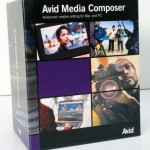Blog Archives
Avid Introduces New Versions for Media Composer and Symphony
 Avid has just announced the launch of version 4 for Media Composer and Symphony to the masses. This new upgrade of Media Composer and Symphony offer improved stereoscopic 3D editing, enabling customers to view 3D material side by side in addition to over/under — ensuring greater accuracy of editing decisions and a wider choice of cost-effective monitors for stereoscopic viewing. Mix and Match is a new function which provides customers with the flexibility to use media sources of different frame rates and resolutions (SD and HD) in the same timeline – eliminating external transcoding and time-consuming frame-rate conversions. Users can monitor HD and SD cross-and-down converted formats from 1080p24 masters. This enables customers using Mojo DX or Nitris DX hardware to view HD material on a less-expensive SD monitor.
Avid has just announced the launch of version 4 for Media Composer and Symphony to the masses. This new upgrade of Media Composer and Symphony offer improved stereoscopic 3D editing, enabling customers to view 3D material side by side in addition to over/under — ensuring greater accuracy of editing decisions and a wider choice of cost-effective monitors for stereoscopic viewing. Mix and Match is a new function which provides customers with the flexibility to use media sources of different frame rates and resolutions (SD and HD) in the same timeline – eliminating external transcoding and time-consuming frame-rate conversions. Users can monitor HD and SD cross-and-down converted formats from 1080p24 masters. This enables customers using Mojo DX or Nitris DX hardware to view HD material on a less-expensive SD monitor.
Avid has also added support for Panasonic AVC-I and Ikegami GFCAM 100MBps formats. The Production Suite versions have been updated to include new versions of Boris Continuum Complete, Sorenson Squeeze and SmartSound SonicFire Pro. On a side note Avid has also introduced new versions of its NewsCutter editor for news broadcasters and Interplay production asset management system.
Interplay 2.0 was upgraded as well which lets broadcasters and post facilities work remotely. Lower bandwidth streaming proxies let Interplay workgroup members work with media anytime from anywhere, using a Mac or PC. Of the numerous added feature of Interplay one which stands out for me is the feature of Final Cut Pro workflow support that offers check-in and check-out of FCP media with project links as well as media and metadata conversion of FCP-to-Avid and Avid-to-FCP projects.
Since FCS 3.0 was recently released, curious minds were wondering when Avid would respond to the Apple’s well received upgrade and they certainly have seemed too. Media Composer and Symphony will be available on September 30. I’ll give a full review when its public.
Credit to the Digital Arts Staff for the specifics of the release.
Final Cut Studio 3, the Pro’s Weigh In
 Well, here we are again. Final Cut Studio 3 has been out long enough now for people to have had the chance to get their spoonful of Apple’s new post production package. What are their thoughts? Well, as we know, e-v-e-r-y-o-n-e has an opinion (unfortunately) and rather than read the tumultuous ramblings of college students or editing wannabes I thought it would be a breath of fresh air to hear what actual studio based editor’s and facilities had to say about it.
Well, here we are again. Final Cut Studio 3 has been out long enough now for people to have had the chance to get their spoonful of Apple’s new post production package. What are their thoughts? Well, as we know, e-v-e-r-y-o-n-e has an opinion (unfortunately) and rather than read the tumultuous ramblings of college students or editing wannabes I thought it would be a breath of fresh air to hear what actual studio based editor’s and facilities had to say about it.
Editor Jonathan Moser (www.flashcutproductions.com) recently purchased the new release and commented:
“It’s not that there are any ‘knocking it out of the park’ features in the new FCP, it’s just well thought out enhancements and new features with increased dynamic interoperability between Studio’s different products. Again, Apple scores more in vision and image than Avid, whose new releases also incorporate increased functionality and versatility, but with much less fanfare…and that’s been Avid’s image problem vs. Apple’s the entire time. Avid was and is an editing company, Apple is more of an event creator, though FCP is and will remain a solid product that will continue to get increasing market share.”
LA-based television producer Tor Johansen also commented on the new release:
“Logistically, I’m excited to see Apple working off of their own timeline with this release. This whopper of an update comes out smack dab in the middle of…nothing. No NAB launch, no surprise announcement at the WWDC, and no ‘one last thing’ at the MacWorld keynote. It gives me more confidence in the shipping product, that it was put out when it was ready, not according to some fading industry calendar.”
Adam Luckwell, CEO of London’s Unit is also keeping close tabs on the new Final Cut package.
“We are obviously eager to use the latest upgrades and believe there will be great improvement to workflows. With the new Studio, Final Cut Pro brings improvements to some of the most frequently used tools and features, such as the powerful and easier to use speed tool, as well as the new ProRes codecs, offering the ability to create higher quality exports but at low file sizes. As well as improvements to existing features it also has the addition of new functions that will make both an editor and client’s life more productive. The new easy export function is an example of one of these, allowing users to set exports rendering out in the background while they are able to carry on working. This could seem like such a small change but in the commercials and advertising sector where approval mpegs are common place it will be especially useful.”
He also commented on the much more streamlined integration between Final Cut Pro and Color, which he believes will cut down on the prep work previously needed between the two.
“This will impact positively on prices as it means less man hours getting a project ready for the grade and will be especially useful in the case of long-form.”
It’s all interesting to hear, and although I haven’t officially commented yet since I’d prefer to take the full package for more than just a test drive before I way in, I did blog on my initial thoughts last month which were mixed. However, to reiterate some of my feelings, I think Apple has certainly taken some good steps here, but more assertively I have agree with editor Jonathan Moser :
“…Apple scores more in vision and image than Avid, whose new releases also incorporate increased functionality and versatility, but with much less fanfare. Avid was and is an editing company, Apple is more of an event creator, though FCP is and will remain (and I’ll ad in, ‘for the most part’ ) a solid product…”
I’ll leave it at that for now.
Panasonic P2 Camera and Avid
I seem to get a lot of questions about shooting 24p from cameramen, as in what I would prefer from them as the editor who will have to deal with footage. Apparently there seems to be different opinions on how one should shoot in order to properly maintain the metadata for post. So I’ve grabbed a tutorial from Avid and posted it below for all to see. It’s not so much about post production as it is how to properly set up for your P2 camera for 24p and be able to properly edit the footage in post. I hope this gives you all some clarification.
Has the World Gone 3D mad?
 It seems as if every movie that’s hitting theatres these days has a 3D version playing somewhere, but what does this mean to the editor? The majority of experienced editor’s have worked in most formats and genre’s by now and most have even decided to learn at least the basics of effects and motion graphics to keep up with the growing expectations of post houses. Now, along comes 3D, and the trend in Hollywood seems to be releasing films in both 3D and 2D versions to please the masses who have latched on to this one time gimmick…but, will it last? Back in the eighties 3D was a quick fad, showing up in selected films and then was gone quicker than Corey Haim’s career. Now it’s back, and with significant improvements to the theatrical viewing experience, the question is growing, will this become the new standard of film and even broadcast? Yes, that’s right, broadcast. If you don’t know already, the NFL is already experimenting with 3D football games having filmed several in the new format last season. Some television studios have already decided to broadcast the occasional show in 3D ( such as the show ‘Chuck’ from Virgin Media) and more and more companies are turning to 3D as a way of being able to provide more of a visual index to their clients.
It seems as if every movie that’s hitting theatres these days has a 3D version playing somewhere, but what does this mean to the editor? The majority of experienced editor’s have worked in most formats and genre’s by now and most have even decided to learn at least the basics of effects and motion graphics to keep up with the growing expectations of post houses. Now, along comes 3D, and the trend in Hollywood seems to be releasing films in both 3D and 2D versions to please the masses who have latched on to this one time gimmick…but, will it last? Back in the eighties 3D was a quick fad, showing up in selected films and then was gone quicker than Corey Haim’s career. Now it’s back, and with significant improvements to the theatrical viewing experience, the question is growing, will this become the new standard of film and even broadcast? Yes, that’s right, broadcast. If you don’t know already, the NFL is already experimenting with 3D football games having filmed several in the new format last season. Some television studios have already decided to broadcast the occasional show in 3D ( such as the show ‘Chuck’ from Virgin Media) and more and more companies are turning to 3D as a way of being able to provide more of a visual index to their clients.
So back to the original question. What does this mean for an editor? Well, at the moment, very little. There is a niche market of editor’s who are being privy to this type of format, and they say there’s definitely a learning curve. When it comes into the edit room you do watch the footage with 3D glasses while your cutting, and you have to extrapolate from multiple screens to link together the final sequence. Basically cutting the left eye footage, then the right eye footage via linked timecode of course.
In terms of hardware and software, a lot of people who are working in 3D ( which is not many comparatively ) are using cheap workarounds such as Sony Vegas ( which is a nightmare ) and working with 3D animation in Adobe AE CS3 ( not recommended but gets the job done ). While these may provide some flexibility to those not wishing to shell out more money, Avid was pleased to announce the industries first Stereoscopic 3D editing with Media Composer.
“Delivering full support of stereoscopic workflows, which enables customers to acquire, edit and display stereoscopic (3D) material. Content can be displayed with stereo monitoring capabilities in both the composer window and full screen playback – eliminating the need for costly conforms previously required to screen 3D material.” – Avid
Along with Avid, Nvidia is starting to pump out high end graphics cards for workstations that can handle the heavy load required to edit in this format along with the ability to view it in full rez. On a side note , Sony has also gone ahead with plans to produce a 3D Blu-ray player and is waiting for the movie studios who were close to reaching agreement on the final format, a decision that is predicted will be finalised by the end of 2009. According to Sony, this would bring the format to consumer market in late 2010.
When you take all this in, yes, it does seem like the the 3D craze is more than just a passing fad this second time around, and from an editor’s perspective all of us are in for a crash course at some point. So consider this fair warning to the lot of us, companies are ramping up it’s use, Hollywood is not letting go, and the tech corporations are preparing for a mass consumer market. So just when you thought you knew it all, along comes a new thing, and this one could shape the way we see the editing room for a while to come.
